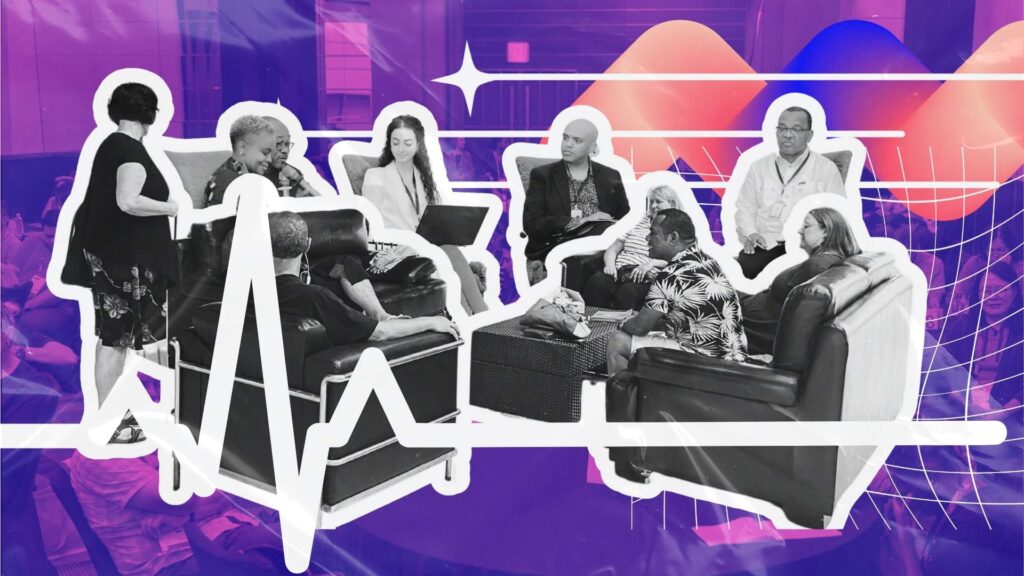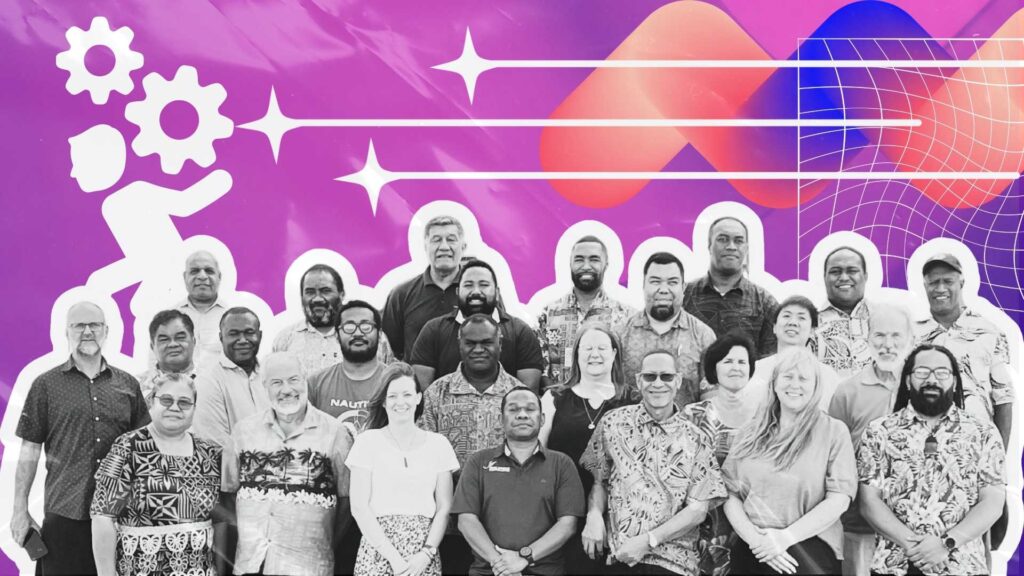A Brief History of the Lausanne Movement and Its Networks
The Lausanne Movement has always been about fostering global collaboration within the evangelical community. Yet, it was not originally intended to be an enduring structure. The First Lausanne Congress on World Evangelization was envisioned as a ‘single event, with no formal follow-on structure.’1 However, during the Congress, participants quickly recognized the need for an ongoing organizational framework to sustain its impact. The idea of a movement was born.
From its inception, the Lausanne Movement prioritized the creation of volunteer-led networks to contextualize its vision. These began as regional and national networks and, since 2010, have expanded to include issue-focused networks. Today, the Movement encompasses 12 regional networks2 and 28 issue networks, which ‘serve as hubs of innovation and collaboration, where diverse voices unite to forge strategies, share insights, and catalyse change.’3 It is unlikely the First Lausanne Congress would have achieved its significant influence without the continued work of these networks.
Lausanne 4 journey built on this legacy and not only focused on one big gathering (even though it was a significant milestone), but also deliberately shifted towards a ‘multi-year, global, polycentric process facilitated by the platform of Lausanne, towards catalytic collaboration of the global church, for the discipling of all nations and the shaping of the world in 2050.’4The hope was that people would participate in the whole Lausanne 4 journey—from being part of listening calls hosted by the different regions and issue networks in 2020 to engaging in regional gatherings, interacting, and praying together in networks, even before the Congress in Seoul-Incheon 2024.5
Why Networks Are Vital for Congresses

Research conducted for a master’s thesis6 highlighted the critical role networks play in sustaining the impact of global gatherings. Both Congresses and networks serve as spaces of inspiration, connections, fellowship, and prayer. So why would you need both if they do the same? This is because for the participants, the experience at the Congress was not just a nice and inspirational memory but it feeds into their discussion at the existing or new networks post- Congress.
Networking at the Fourth Lausanne Congress (onsite)
The Congress was designed to deepen participants’ connection to God’s mission and the global church, fostering a sense of togetherness, belonging, and empowerment for leaders from across the globe to embark on a journey of collaborative action.7
In other words, networking in the sense of connecting was a major part of the intention and therefore a lot of effort was done to enable it, building on the Lausanne 4 journey. Before the Congress in September, participants were invited to several pre-Congress calls and WhatsApp groups, where they could already meet other participants, share their stories, and pray together. During the plenary sessions all participants were divided into table groups and time was given to engage with one another, discuss the topic, and pray together around the tables. In the afternoon people could continue to meet in collaborative sessions.
For these afternoon sessions participants were able to choose a gap,8 a topic that was identified in the State of the Great Commission Report as one of the major gaps in fulfilling the Great Commission, before the Congress. The collaboration sessions took the group through a four-step process: to listen and reflect about the gap, to imagine a preferred future, to create possible ways to close the gap, and to communicate the proposal.9 During their free time, participants could connect with leaders and those involved in the Lausanne issue networks and regions through dedicated meetings and the Movement desk. Furthermore, two apps were created to help to facilitate connections: the Lausanne gatherings app—where participants could find and engage with other participants and the gathering schedule, and the Action Hub—a dedicated tool to connect people who wish to collaborate further in their respective interest groups.
Experience of Participants in Networking
According to the post-Congress survey which had a response rate of almost 20 percent,10the programme elements concerning connecting were rated very high—in average from 4.01 (positive) to 4.38 (very positive).11
- Movement Desk: Discovered more about the Lausanne Movement—4.38
- Issue Networks: Connecting with others who share a similar passion—4.29
- Regional Networks: Engaging with others in my region—4.06
- Afternoon Sessions: Collaborate—4.01
While most of the participants already knew a regional network, 22.14 percent said they engaged for the first time with an issue network.
The provided networking tools and opportunities were used by the majority of the participants:
- Downloaded the Lausanne Gatherings app: 89.67 percent
- Building new friendships and connections that will last beyond the Congress: 77.77 percent
- Finding potential partners for future collaborative projects: 59.26 percent
- Signed up for the Lausanne Action Hub: 57.77 percent
- Joined the Congress participant WhatsApp community: 57.40 percent
When participants were asked how God worked in them during the Fourth Lausanne Congress 74.51 percent chose ‘Connected with like-minded leaders and built lasting relationships’ making it the second most common response after ‘Experienced and engaged with the diversity of the global church’ (74.79 percent). An additional 62.13 percent said they were able to identify and engage in opportunities for collaboration with others.12
However, 40.8 percent also said that there was not enough time for engagement and networking, when they were asked for improvements.
Insights from Network Leaders13

Network leaders, surveyed separately, provided additional insights. With a response rate of 57 percent among issue network catalysts and 67 percent among regional directors, the survey yielded a strong level of participation. It focused broadly on their networks and the support provided by the Lausanne Movement.
During the Lausanne 4 journey, each of the 12 regions hosted a regional gathering, with three regions combining their events into a single hybrid gathering. In total, these included three hybrid, four in-person, and three virtual gatherings, involving approximately 2,400 participants. In addition, several national gatherings and events hosted by issue networks were conducted. Altogether, an estimated 10,300 people participated in these gatherings. This number also includes virtual events, such as webinars hosted by issue networks to explore specific areas of expertise, even if not directly connected to Lausanne 4. Overall, more than 120 gatherings were hosted by the 28 issue networks and 12 regions in 2023 and 2024, averaging three gatherings per network.
Regarding the growth or decline of engagement in the networks, one-third reported no growth or a decline in engagement between 2020 and 2024. Among the remaining networks, growth rates varied significantly, ranging from 9 percent to 1,900 percent (eg one network grew from 50 to 1,000 participants).
Given the wide variation in network sizes (some starting with 30 participants, others with 1,000), a combined projection was performed. This analysis indicated that approximately 44,000 people were engaged in networks under the Lausanne Movement in 2020, with that number growing by about 17 percent to 51,500 in 2024.
No clear correlation was observed between the number of gatherings hosted and the growth rate of network engagement. Some networks experienced a decline due to factors like confusion over nomination, selection, and registration processes, which led to a loss of trust among participants and leaders. Further investigation would be required to fully understand these dynamics.
Support and Challenges for Network Leaders

All network leaders are either volunteers managing their networks in their free time or individuals seconded by their organizations, allowing them dedicated time to lead an issue network or a region.
Most issue networks have more than one catalyst who is an expert and practitioner passionate on the particular issue. The regions have, in recent years, invested in building regional teams co-led by two regional directors.
The operations and communications teams provide various forms of support, including creating templates and branded materials, promoting gatherings via the website, email, and social media, and hosting events on the organization’s Zoom account. For regional gatherings, additional support was recruited to handle registrations, virtual hosting, and other logistical
tasks. Over 60 percent of network leaders use support in the form of templates and assistance for gatherings, while another 45 percent use Lausanne as a platform to publish articles, raising awareness about their region or issue network.
The biggest challenge identified by network leaders in staying connected with their members was overwhelmingly limited time capacity. Financial constraints and difficulties in managing administrative and data-related tasks also pose significant obstacles to communication within their networks.
This feedback aligns with leaders’ suggestions for helpful support: two-thirds highlighted the need for assistance with administrative tasks, as well as tools to facilitate efficient and secure communication with their networks. Streamlining these processes would free leaders to focus more on the core tasks of networking and collaboration.
Conclusion
The Fourth Lausanne Congress showcased the critical role of networks in advancing the Lausanne Movement’s mission. It successfully fostered connections, collaboration, and ongoing engagement through innovative tools and a multi-faceted approach. However, the disparities in network growth and feedback from leaders reveal areas for improvement, particularly in providing administrative and communication support to alleviate the burdens on volunteer leaders.
To ensure the Movement’s continued vitality and effectiveness, prioritizing streamlined support systems, enhancing resource allocation, and refining engagement strategies will be essential. By addressing these challenges, the Lausanne Movement can empower its networks to play an even greater role in catalysing global mission efforts, ensuring the Movement’s enduring impact.
Endnotes
- Leighton Ford’s forward in Leighton Ford and Michael Oh, The Lausanne Legacy – Landmarks in Global Mission (Peabody, MA: Hendrickson Publishers, 2016).
- ‘Regions’, Lausanne Movement, accessed 10 December 2024, https://lausanne.org/network-type/regions.
- ‘Issue Networks’, Lausanne Movement, accessed 6 December 2024, https://lausanne.org/issue-networks.
- Michael Oh, ‘What Is Lausanne 4’, Lausanne Movement, accessed 6 December 2024, https://lausanne.org/l4.
- See also Sandra Kunze, ‘The Transformative Power of Networks’, accessed 6 December 2024, https://lausanne.org/about/blog/the-transformative-power-of-networks.
- See Kunze, ‘The Transformative Power of Networks’
- View ‘Introduction to Collaborate’, https://youtu.be/IIt3spXN3Rs?si=ipK2C9QrXgGrZEjb.
- See all 25 gaps that were identified through the State of the Great Commission Report here: https://Congress.lausanne.org/the-25-collaborate-session-gaps/.
- See ‘Congress Executive Summary of Afternoon Programme’, accessed 12 December 2024
- 1075 responses of the 5394 participants (19.93 percent).
- Response choices: 1 – very negative, 2 – negative, 3 – neutral, 4 – positive, 5 – very positive.
- The difference between the results of the question ‘How did God work in you during the Fourth Lausanne Congress?’ (Multiple choice question)—62.13 percent selected ‘Identified and engaged in opportunities for collaboration with others’, and the question, ‘New Connections – Which of the following connection tools and opportunities have you engaged in?’ (Multiple choice questions)—59.26 percent selected ‘Finding potential partners for future collaborative projects’, is so small it can be used as a confirmation.
- To simplify the language, catalysts and regional directors are labeled as network leaders.

